3 products serving local voters that you can learn from for your 2024 election coverage
Jan Ross Sakian, American Press Institute,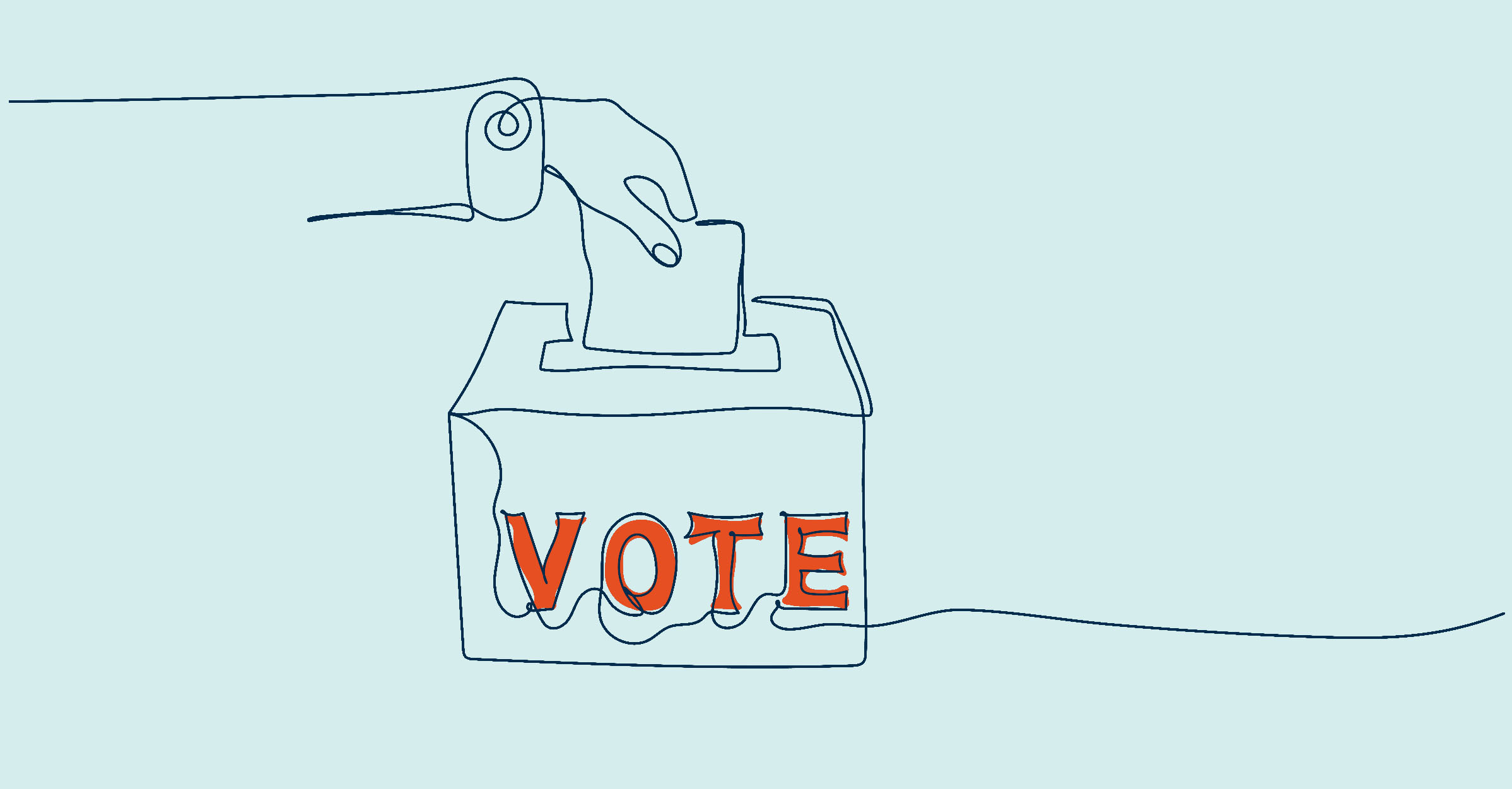 Here are three ideas to steal and adapt: LAist, Enlace Latino NC and Spotlight PA developed easy-to-use tools for voters during local elections.
Here are three ideas to steal and adapt: LAist, Enlace Latino NC and Spotlight PA developed easy-to-use tools for voters during local elections. This is a series on Better News to a) showcase innovative/experimental ideas that emerge from the Knight-Lenfest Newsroom Initiative and b) share replicable tactics that benefit the news industry as a whole.
These “wins” come from Ariel Zirulnick, director of news experimentation for LAist (Southern California Public Radio,) Nicolás Baintrub, senior reporter and newsletter editor for Enlace Latino NC, and Elizabeth Estrada, democracy editor for Spotlight PA. Southern California Public Radio participated in the Poynter Table Stakes program in 2018-19. Enlace Latino NC participated in the UNC program in 2020-21 and the Live Event Sprint for Table Stakes Alumni in 2024.
Covering elections is a heavy lift for every news team, but elections also provide an opportunity for journalists to plan ahead and examine how they can improve their coverage.
In April, the Table Stakes Local News Transformation Program hosted lightning talks from three nonprofit news journalists who shared their strategies:
- Ariel Zirulnick, director of news experimentation for LAist (Southern California Public Radio), talked about her team’s “Make It Make Sense” newsletter for 2024 election results.
- Nicolás Baintrub, senior reporter and newsletter editor for Enlace Latino NC, shared how he and his colleagues tweaked the design of their interactive voter guide design ahead of the North Carolina primaries.
- Elizabeth Estrada, democracy editor for Spotlight PA, demonstrated a beta version of the organization’s 2024 Election Assistant.
Here’s a look at the three voter-focused products:

“The Make It Make Sense” newsletter features data visualizations showing election result updates over time. Prop. 1 passed on a narrow margin, and the ballot initiative would shift much of California’s millionaires tax for mental health services towards housing for people with mental illness. (LAist)
LAist’s pop-up newsletter focusing on results after Election Day
Zirulnick shared how LAist fine-tuned its email acquisition strategy for the 2024 election season based on lessons learned in 2022.
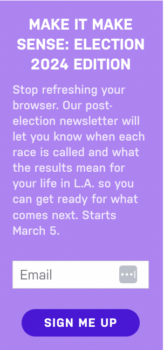
A widget allowed subscribers to sign up for the “Make It Make Sense” newsletter on laist.org. (LAist)
What they did and why: The team developed a limited-run, post-election email newsletter, called “Make It Make Sense,” to complement its voter guide and accompanying election initiatives. LAist identified the time between election night and race calls as a “white space,” a news moment for which no other local newsrooms had developed an editorial product. It takes weeks to complete vote counts in California because of the high use of mail-in ballots.
“Make It Make Sense” encouraged Angelenos to sign up ahead of the March 5 primaries, so they could receive updates on ballot counts and results.The newsletter informed subscribers about the electoral process as it unfolded and also added context about what the election results said about L.A. more broadly.
What worked well: The team decided to develop an election-specific product that could serve as an initial touchpoint for audiences who don’t typically interact with LAist’s content. Knowing that Voter Game Plan guides bring in more traffic around election time, the team sought to capture email addresses from a slice of civically engaged users who wanted to stay informed about elections.
The LAist team built this strategy from what they learned after the previous election cycle. In 2022, LAist experimented with a five-issue newsletter course called “The Ballot is Long,” which explained complicated ballot items to voters through repackaged voter guide information. The product performed well, garnering about 2,500 signups. However, the team observed that most subscribers were already loyal users who already engaged with existing content.
With“Make It Make Sense,” Zirulnick and her colleagues sought to deliver “moment-in-time” updates unique to the 2024 local elections and their outcomes. The final product also prioritized data visualizations and conversational, accessible language to make the takeaways digestible and easy to remember.
LAist’s goal for “Make It Make Sense” was 3,000 subscribers, including 50% who were new to the organization. They succeeded with about 4,500 subscribers — about 3,000 of whom were new to LAist, representing 68% of signups.
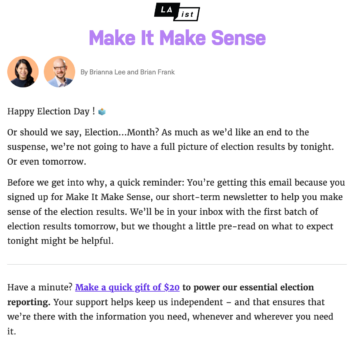
The first edition of “Make It Make Sense” on March 5, 2024 introduced subscribers to what they could expect from the newsletter and included a clear appeal for contributions to support the work. (LAist)
What didn’t work as expected: LAist had hoped that a post-election newsletter would also be a good way to convert appreciative readers to paying members. While the team didn’t have a specific goal for membership, the number of contributions via “Make It Make Sense” was fewer than expected and they received less than $1,500. A few factors could have contributed: first, much of the mailing list was new to LAist and probably needed more cultivation. Most of the rest of the list consisted of current members. Second, the newsletter’s limited run coincided with the newsroom’s spring membership drive, so many people might have donated via a different appeal.
The newsletter team experimented with writing in-line membership appeals in the body of the email, in addition to membership banners at the top of each installment. The in-line appeals did not convert at a higher rate than the banner.
Try this:
- Consider the user experience and think about offering a complete reading experience in a subscriber’s inbox by making the copy skimmable and the visuals easier to read, rather than chasing click-throughs to the main site.
- There can be room to experiment with your publishing cadence. LAist did not commit to a specific publishing schedule, instead telling subscribers “We’ll be in your inbox when there are results to share – and we won’t bother you when there aren’t.” To keep the mailing list active between elections, LAist will send out an explainer about one part of the election process every month before ramping up again in September.
- Think about what the wider audience needs to know about your business model. If the product brings value to them, how can they support the news organization? Outlining how to donate or become a member or subscriber in creative ways during a new launch can help shape your next set of goals.
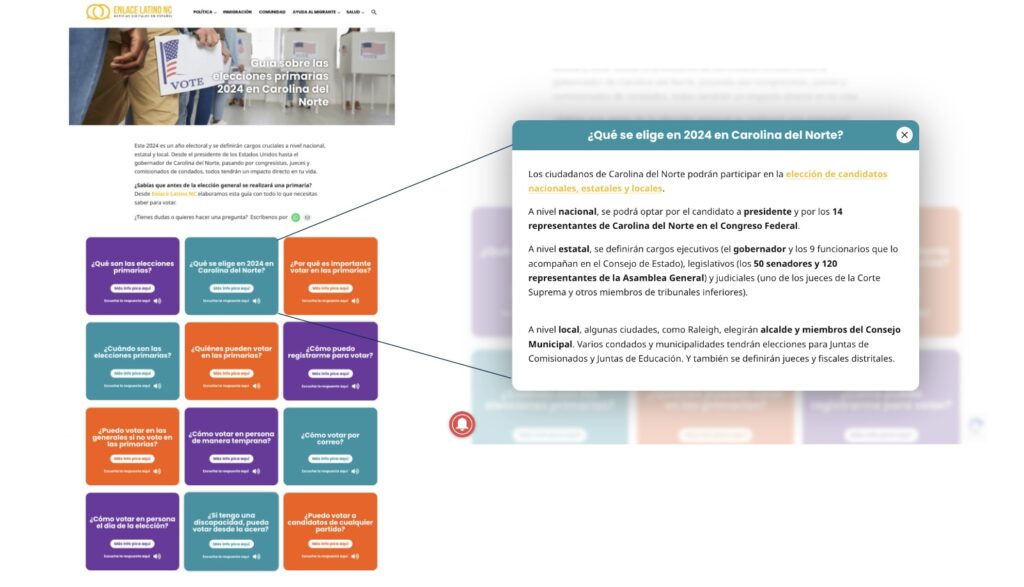
Enlace Latino NC’s voter guide for state primaries shows answers to election-related questions with one click. (Enlace Latino NC)
Enlace Latino NC’s interactive guide to explain state primaries in Spanish
Baintrub shared how Enlace Latino NC created a tool that explains the North Carolina primaries to Spanish-language audiences. Enlace Latino NC is a non-profit, digital-native, Spanish-language news outlet that covers politics, immigration, and community and state issues for Latino immigrants in North Carolina.
What they did and why: The Latino community is the fastest growing demographic group in North Carolina over the last decade. The group grew by nearly 40% between 2010 and 2020, and there are now more than 1 million Latinos living in the state. But while Hispanic folks represent about 10% of the population, they represented only 1% of voters in the March 2024 primary election.
When talking to members of Spanish-speaking communities, the staff at Enlace Latino NC often hear complaints about the lack of “simple and accessible information in our first language.” To address that gap, the team decided to create a practical guide to the state’s March primaries. The goal was to address two key facets of the electoral process:
- How to vote: who can vote, voter registration and polling places and times
- Why it’s important to vote: explaining the purpose of primaries, which positions are being elected and how results can impact life in North Carolina
The guide is interactive and free to access online. This was intended to lower the economic barrier that can often keep eligible voters from participating at the polls.
What worked well: Baintrub said teamwork was fundamental to creating the guide. The staff used these engagement tools:
- Community events
- Non-partisan forums where the public can address candidates directly
- WhatsApp channel
- Newsletter email replies
To create the product they envisioned, Enlace Latino NC worked with two freelance professionals: a web designer to build the guide’s functionality and a graphic designer to make a simple design visually appealing.
What didn’t work as expected: Informed by focus groups and surveys of reader needs, Enlace Latino NC has made issue guides in the past on hurricane preparedness, agricultural worker rights and Medicaid expansion in North Carolina.
But users had to click multiple times to get to the answers and the copy wasn’t always concise. The team made changes in the 2024 primary guide to improve the user experience and added functionalities like a clickable audio explainer for each question, which Baintrub voiced.
Try this:
- Prioritize the user experience so it takes the fewest possible clicks to get to an answer – ideally just one click.
- When writing FAQs for audiences, focus the content through short answers of no more than a few paragraphs. You can also experiment with different ways to communicate the information, like audio clips.
- Decide on a design and functionality that suits your needs, then replicate and tweak it for future projects.
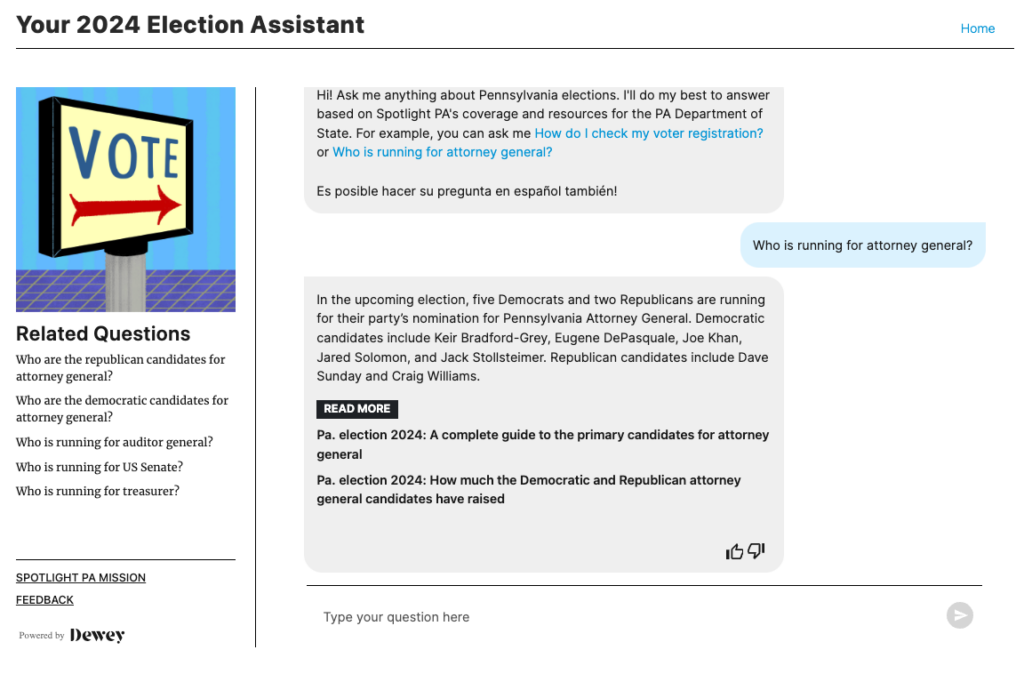
A demonstration of Spotlight PA’s 2024 Election Assistant, which uses their reporting as the foundation for responses to questions about the voting process in Pennsylvania. (Spotlight PA)
Spotlight PA’s 2024 Election Assistant for voting in Pennsylvania
Estrada shared some background on Spotlight PA’s 2024 election offerings and demonstrated a beta version of a new interactive tool that answers questions about Pennsylvania elections in English and Spanish.
What they did and why: Spotlight PA is an independent, nonpartisan and nonprofit newsroom that produces investigative and public service journalism about Pennsylvania state government and urgent statewide issues. For the 2024 election, Spotlight PA is focused on connecting the stakes of each race to the lives of Pennsylvanians, monitoring and explaining election administration and combating misinformation.
Estrada manages a voter-centric and election-focused project called the Democracy Initiative. Her goal is to reach as many voters as possible, while also trying to reach younger and more diverse voters in the state.
The big project for this year is Spotlight PA’s 2024 Election Assistant, an interactive discussion tool that combines AI technology and the organization’s reporting by answering queries related to voting in Pennsylvania. Estrada said that developing the tool supports the organization’s ongoing mission to combat misinformation, share resources and build bilingual content to reach Spanish-speaking communities in the state.
What worked well: Spotlight PA offers a range of products and resources specific to Pennsylvania’s electoral process, including candidate guides, events and voter tools and guides in English and Spanish.
This work — which has been reported and fact checked by the Spotlight PA team — is the foundation of the Election Assistant’s database of content, supplemented with public information from the Pennsylvania Department of State website. The tool generates answers to questions about general election issues and the voting process in Pennsylvania, like who is running for specific races and how to find more information about mail-in voting.
Through this process, Spotlight PA and its partners at the AI startup Dewey developed a voice for the tool and a design for the interface. They imported content, manually reviewed the tool’s responses and, in some cases, specifically drafted answers to sensitive questions.
What didn’t work as expected: This AI project is an experiment for Spotlight PA and currently in beta testing. The team’s goal is to have a version ready for the general election in November, so Estrada and her colleagues focused their efforts on testing ahead of the April primaries. The tool has several different features and functions including translations, citations and links. Bugs need to be fixed and, sometimes, outdated articles pulled into the database require manual updating.
The Spotlight PA team is small, but each member fulfills a specific content, project management or web design role . As the project progressed, Estrada said that her team slowly opened up more project-related responsibilities to staff and shared more information about the experiment with trusted audiences. Although the feedback from stakeholders was mostly positive, there’s still some skepticism related to how news organizations can utilize AI technology in general.
Try this:
- Learn with others working on similar projects. Estrada said it was helpful to be involved with other newsrooms that are also experimenting with AI technology. Spotlight PA is involved in AI-focused cohorts through the Online News Association and the American Journalism Project, which funded the experiment.
- Remember that patience and flexibility are keys to successful experimentation. Estrada said that “taking it slow” made it easier for the Spotlight PA team to manage the project over the course of several months and ensure accuracy was always the priority.
- When gathering feedback for a product in development, invite people to share their thoughts in writing. Spotlight PA received a range of responses from early tests outside of the organization about the quality of the user experience, what they learned from the Election Assistant and the impact the tool could have for voters in Pennsylvania.